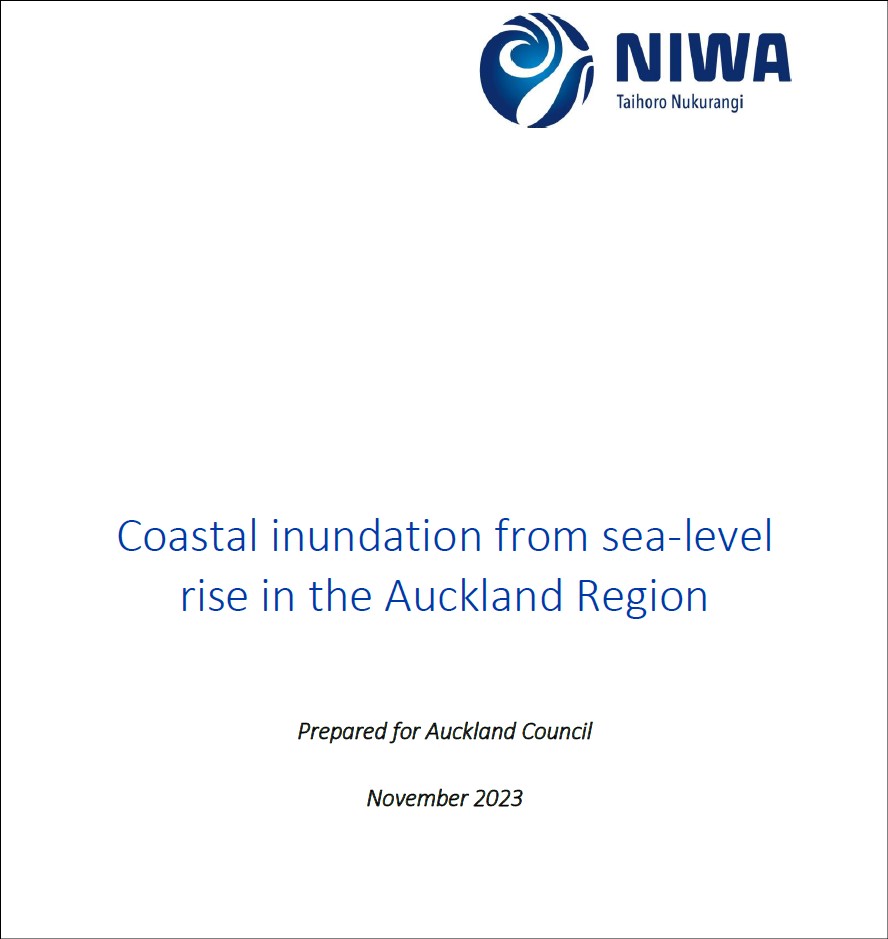Coastal inundation from sea-level rise in the Auckland region
Author:
National Institute of Water & Atmospheric Research Ltd, NIWASource:
Auckland Council, NIWAPublication date:
2023Topics:
EnvironmentExecutive summary
Auckland Council commissioned NIWA to identify changes in the extent of coastal inundation from sea-level rise. For the purposes of this study, coastal inundation is defined as land that is or would become intertidal because of sea-level rise, assuming no change in ground level i.e., no accretion, erosion, or landslides. In the absence of adaptation it would be regularly inundated by spring tides in the future.
This is different from coastal flooding, which may cause extensive but only temporary flooding, and is addressed elsewhere (Auckland Council 2020). This study addresses coastal inundation mapping for the entire Auckland region based on mean high water spring tide (MHWS) levels relative to present-day mean sea level, plus increments of relative sea-level rise (RSLR). It does not consider the effects of storm surge or wave processes on total water levels including wave set-up and run-up nor catchment-based flooding and groundwater. The line of MHWS legally defines the land-sea boundary, so mapping of the land area exposed to inundation by MHWS + RSLR effectively shows land that could become “sea” in the future.
The MHWS elevation was defined as MHWS-10, which is the level equalled or exceeded by the largest 10% of all high tides. MHWS-10 was adopted by NIWA on the basis that it provides a nationally consistent estimate of MHWS that is unaffected by regional changes in individual tidal harmonic constituents. MHWS-10 has also been shown to provide a good match to the physical coastline boundary in the Auckland region (Stephens & Wadhwa, 2012). The MHWS-10 tide levels were calculated at intervals along the region’s coastline using available tide-gauge records and numerical hydrodynamic models.
Mean sea level (MSL) estimates were updated for the 2001–2019 period for the Auckland Region, relative to Auckland Vertical Datum 1946 (AVD-46). MHWS-10 heights (relative to mean sea level) were added to the updated MSL to estimate present-day MHWS levels. Fixed increments of sea-level rise in 0.5 m increments (0.5, 1.0, 1.5, 2.0, 2.5, 3.0 m) were subsequently added to provide inundation water levels (WL) relative to AVD-46. This can be represented as WL = 2001–2019 MSL + MHWS-10 + future RSLR.
An Innovative methodology was developed within GIS to map the inundation water levels to the land area to ensure the levels were applied to a land parcel from where it is connected to the coast. Areas of future inundation were identified by intersection of the inundation water levels with the 2016–2018 LiDAR generated digital elevation model (DEM) of the coast.
Areas of future inundation were identified using a static mapping method. In this method, all land below the inundation water levels and with a physical connection to the sea is shown as flooded in its entirety. This a reasonable assumption for modelling permanent inundation caused by mean sea level change and regular tides, due to the regular nature of such inundation plus occasional additional flooding from higher tides and storm-tides and compound flooding from tidal locking of fluvial/pluvial discharge.
The identified inundation areas were checked for connectivity to the sea using the Auckland Council’s stormwater linear features like channel, pipe, connection and overland flow paths.
NIWA has provided Auckland Council with maps of the region’s exposure to coastal inundation. The maps were provided as GIS polygon extents of the areas of inundation and raster files of the depth of inundation.
Auckland Council, NIWA, November 2023
